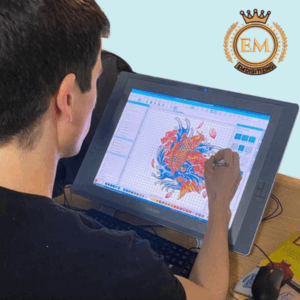What Best Materials Do You Need to Start Your Embroidery Business In 2023
Introduction:
Embroidery is a versatile and profitable business that allows individuals to turn their passion for stitching and creativity into a successful venture. Whether you’re just starting or looking to upgrade your existing embroidery business, having the right materials and embroidery machine supplies is crucial for achieving high-quality and professional results. In this article, we will explore the essential supplies for embroidery you need to start your embroidery business in 2023.

What Best Materials Do You Need to Start Your Embroidery Business In 2023
Essential Materials You Need To Start Your Embroidery Business In 2023

Embroidery Machine:
Investing in a reliable and efficient embroidery machine is the backbone of your business. Look for a embroidery machines for beginners that offers a wide range of embroidery options, multiple hoop sizes, easy design transfer methods, and a user-friendly interface. Consider factors such as stitch quality, speed, and compatibility with different fabric types.
Embroidery Software:
Quality embroidery software enables you to create, edit, and digitize designs with precision. Look for software that offers advanced features like lettering options, design manipulation, and compatibility with popular file formats. Ensure the software is user-friendly, allowing you to streamline your design workflow.
Stabilizers:
Stabilizers play a crucial role in ensuring the fabric remains taut and stable during the embroidery process. Choose a variety of stabilizers suitable for different fabric types, weights, and embroidery techniques. Stabilizers can be categorized as cut-away, tear-away, or wash-away, depending on their removal method.
Embroidery Threads:
Building a collection of high-quality embroidery threads is essential for achieving vibrant and durable designs. Invest in a range of colors, including basic and popular shades using an embroidery machine, to cater to various customer preferences. Choose threads that are colorfast, strong, and suitable for the fabric you’ll be working with.
Embroidery Needles:
Selecting the right embroidery needles ensures clean and precise stitching. Different fabrics and thread weights require specific needle types and sizes. Invest in a variety of needles, such as sharp-pointed needles for woven fabrics and ballpoint needles for knits, to achieve optimal results.
Hoops and Frames:
Embroidery hoops and frames hold the fabric securely in place, preventing shifting or puckering during the stitching process. Acquire different hoop sizes to accommodate various design dimensions. Consider investing in magnetic or clamp-style hoops for easier fabric repositioning.
Scissors and Thread Snips:
Having a reliable pair of embroidery scissors and thread snips is essential for trimming threads and cutting fabric accurately. Choose sharp, precision scissors with a comfortable grip. Thread snips are handy for quick thread trimming during stitching.
Marking Tools:
Marking tools like water-soluble pens, chalk pencils, or fabric markers help you transfer machine embroidery for beginners designs onto fabric accurately. These tools allow you to outline the design or mark reference points without leaving permanent marks on the fabric.
Reference Materials:
Building a library of embroidery reference materials, such as books, magazines, and online resources, provides inspiration, design ideas, and technical guidance. Stay updated with the latest trends, techniques, and embroidery styles to offer diverse options to your customers.
Bobbins and Bobbin Thread:
Having an ample supply of bobbins and bobbin thread is crucial for smooth and uninterrupted embroidery. Choose high-quality bobbins that fit your embroidery machine and wind them with compatible bobbin thread.
Embroidery Backing:
Embroidery backing provides additional support to the fabric, reducing puckering and improving stitch quality. Invest in a variety of backing types, such as cut-away, tear-away, and wash-away, to accommodate different fabric and design requirements.
Embroidery Designs:
Expand your design library with a wide range of embroidery designs. You can purchase pre-made designs online, collaborate with designers, or create your own using embroidery software. Having a diverse collection of designs allows you to cater to various customer preferences and customization requests.
Fabric Swatches:
Keep a selection of fabric swatches on hand to showcase different fabric options to your customers. This helps them visualize how the embroidery will look on different fabrics and assists in making fabric selection decisions.
Embroidery Thread Storage:
Organize and store your embroidery threads properly to maintain their quality and prevent tangling. Invest in thread storage solutions such as thread racks, spool cases, or thread boxes to keep your threads easily accessible and protected from dust and sunlight.
Embroidery Machine Maintenance Tools:
To keep your embroidery machine in optimal working condition, have maintenance tools like cleaning brushes, lint rollers, and lubricants. Regularly clean and lubricate your machine as per the manufacturer’s instructions to prevent buildup and ensure smooth operation.
Backing and Topping Adhesive Sprays:
Adhesive sprays are useful for securing the fabric, backing, and topping layers during the embroidery process. They prevent shifting and ensure precise stitching, particularly for delicate or slippery fabrics.
Embroidery Digitizing Services:

If you’re not proficient in digitizing designs yourself, consider outsourcing embroidery digitizing services. This allows you to convert artwork or logos into embroidery-ready files, saving time and ensuring professional results.
If you want to customize embroidery digitizing, EM DIGITIZING will be your best choice. At EM DIGITIZING, we deliver the best embroidery logo digitizing services with the best quality. We offer 50% off on all our services to our potential customers on their first order. So, get a free quote now and we will get in touch with you.
Display and Packaging Materials:
Invest in display materials such as garment racks, mannequins, and signage to showcase your embroidered products effectively. Additionally, consider packaging materials like branded tags, labels, and gift boxes to present your finished products attractively.
Remember, the specific materials you’ll need may vary based on the scale and focus of your embroidery business. It’s important to assess your business goals, target market, and the types of projects you plan to undertake to determine the optimal range of materials required for your specific needs.
Tips To Consider When Starting Your Embroidery Business

Here are some tips to consider when starting your embroidery business:
- Conduct thorough market research to understand the demand for embroidery services in your target market. Develop a business plan that outlines your goals, target audience, pricing, marketing strategies, and financial projections.
- Invest in reliable and high-quality embroidery with machine for beginners, digitizing software, and other necessary equipment. Choose beginning machine embroidery that can handle a variety of fabrics and designs to cater to different customer preferences.
- Enhance your embroidery skills through practice and training. Attend workshops, online courses, or seek mentorship from experienced embroiderers to learn new techniques and stay updated with industry trends.
- Create a portfolio showcasing your best embroidery work. Include a variety of designs and embroidery machine for clothes types to demonstrate your versatility and craftsmanship. This will help attract potential clients and showcase your skills.
- Determine competitive and profitable pricing for your embroidery services. Consider factors such as material costs, machine running time, complexity of the design, and your time and expertise. Ensure your pricing covers all expenses and allows for a reasonable profit margin.
- Develop a strong brand identity and create a professional website and social media profiles to showcase your work. Utilize online platforms, local advertising, and networking opportunities to promote your business and attract customers.
- Provide excellent customer service to build a loyal customer base. Respond promptly to inquiries, communicate clearly, and deliver projects on time. Aim for customer satisfaction and strive to exceed their expectations.
- Collaborate with other businesses or individuals in related industries such as clothing boutiques, event planners, or promotional product companies. Establishing partnerships can lead to referrals and mutually beneficial opportunities.
- Stay updated with the latest embroidery techniques, trends, and technology advancements. Attend trade shows, join industry associations, and engage in online forums or communities to stay connected with fellow embroiderers and industry experts.
- Maintain consistency in your embroidery work by establishing standardized processes and quality control measures and know the basics of how to use an embroidery machine. Ensure proper thread tension, accurate design placement, and attention to detail to deliver high-quality finished products consistently.
- Encourage customers to provide feedback and reviews about your services. Positive reviews and testimonials can help build trust and attract new customers. Address any concerns or issues promptly to maintain a good reputation.
- Consider offering additional services such as custom digitizing, monogramming, or personalized embroidery to expand your business and cater to a wider range of customer needs.
Conclusion:
Starting an embroidery business requires careful consideration of the essential machine embroidery supplies to ensure consistent and high-quality results. Invest in a reliable embroidery machine (but before that know how to embroider with a machine and how to use an embroidery machine), software, stabilizers, threads, needles, hoops, scissors, marking tools, and reference materials. By equipping yourself with the right embroidery machine supply, you’ll be well-prepared to embark on a successful embroidery business journey in 2023. Remember, right materials for embroidery is key and to stay creative, continually improve your skills, and provide excellent customer service to thrive in this competitive industry.
Hope this article will be helpful for you guys!
If there’s any question related to this article feel free to comment to us. And, thanks for reading!
To start embroidering, you will need materials such as fabric, embroidery thread, embroidery needles, embroidery hoop, scissors, and a pattern or embroidery design to embroider.
To start your own embroidery business, you need to create a business plan, invest in high-quality embroidery equipment, establish your target market, and promote your services through marketing and networking.
Embroidery can be a good business to start as it offers a creative outlet, has a wide range of potential customers, and allows for customization and personalization, which is in high demand.
The best material for machine embroidery depends on the desired outcome, but commonly used fabrics include cotton, linen, and denim for their stability and ease of stitching.
The six basic kinds of embroidery are counted thread embroidery, surface embroidery, whitework embroidery, needlepoint embroidery, crewel embroidery, and cross-stitch embroidery. Each technique has its own unique characteristics and stitching methods.
